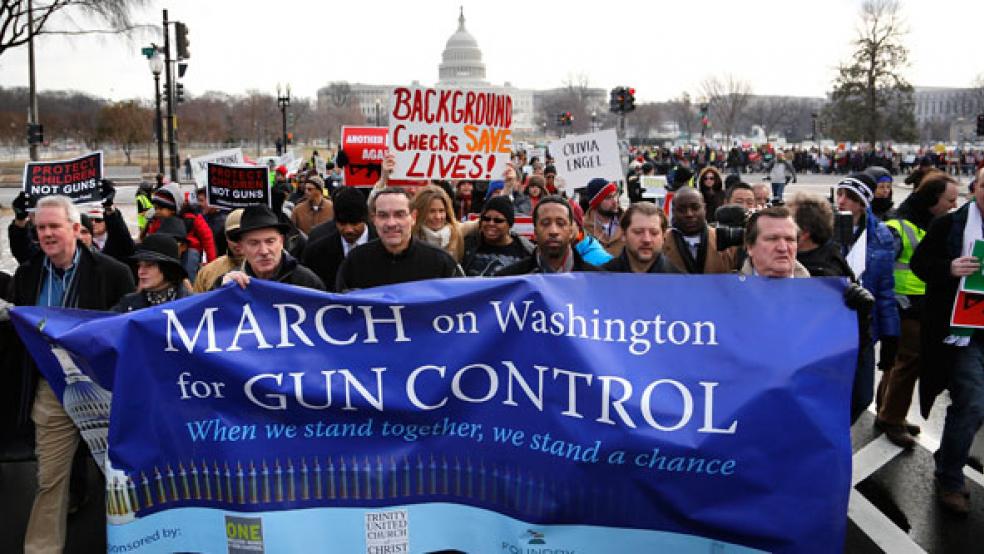The Sparks, Nevada, school shooting has once again ignited a long and bitter debate about comprehensive gun control.
On Monday, a middle school student wielding a semi-automatic handgun belonging to his parents shot and killed a math teacher and critically injured two classmates – before turning the gun on himself.
Many are wondering: Will yet another shooting do anything but raise a few concerned eyebrows?
The shooting occurred just as students were filing in for the start of their school day. “A kid started getting mad and he pulled out a gun and shoots my friend, one of my friends, at least,” a seventh-grade student identified as Andrew Thompson told local TV station KOLO, according to Reuters. “He walked up to a teacher and says, ‘Back up.’ The teacher started backing up and he pulled the trigger.”
The math teacher killed at Sparks Middle School was identified by his family as 45-year-old Michael Landsberry, a former Marine. The two wounded students were in stable condition as of Monday night.
RELATED: 12 WEAPONS THAT CHANGED EVERYTHING
The shooting was just the latest in a rash of such incidents – including one last December 14 in Newtown, Connecticut, in which 20 elementary school children and six adults were killed at Sandy Hook Elementary School. A mass shooting at the Washington Navy Yard in September by a mentally ill 34-year-old man named Aaron Alexis, who had complained of hearing voices, also left 12 people dead.
An outraged and sorrowful President Obama asked the nation last December after the Newtown school shooting, “Are we really prepared to say we’re powerless in the face of such carnage, that the politics are too hard?” He enlisted Vice President Joe Biden to run the biggest gun control push in generations – urging Congress to approve an assault weapons ban and background checks for all buyers.
Lobbyists for the National Rifle Association and lawmakers from anti-gun control districts prevented much of anything from moving forward.
The total economic impact of the U.S. firearms industry in 2012 was estimated to be nearly $32 billion, according to the National Shooting Sports Foundation, up from $27.8 billion in 2009.
Former Rep. Gabrielle Giffords (D-AZ), herself a victim of gun violence, and her astronaut husband, Mark Kelly, have been leading a national movement to promote checks on gun buyers. The couple owns their own guns. During his attendance at a gun show recently, Kelly said, “At the federal level we still have no requirement for background checks at gun shows, but states like New York are fixing the loophole. [New York’s] model helps keep guns out of the hands of people who shouldn’t have them, like criminals and the dangerously mentally ill, without infringing on our Second Amendment rights.”
The Empire State has created a new code of conduct, spearheaded by State Attorney General Eric Schneiderman, in which gun show organizations agree to conduct background checks at their events.
Giffords and Schneiderman explained it this way in a Washington Post opinion piece: “Guns are tagged at the entrance to the show. Show operators provide access to federally licensed gun dealers to do background checks before completing a sale. All guns are checked on the way out to ensure that background checks were performed.”
After the Newtown tragedy, meanwhile, many schools this year ramped up security measures, including new ID requirements and scanners at building access points, more security cameras and even armed guards.
Here are some of the deadliest shootings in the country to date – though they’re hardly the only ones:
- At Virginia Tech University in Blacksburg, VA, 32 people were gunned down on April 16, 2007, by 23-year-old student Seung-Hui Cho, who then committed suicide.
- At Sandy Hook Elementary School in Newtown, CT, 27 people (including 20 children) were killed on Dec. 14, 2012, by Adam Lanza, age 20, who also killed his own mother. He then committed suicide.
- At Lubys Cafeteria in Killeen, TX, 23 people were fatally shot on Oct. 16, 1991, after 35-year-old George Hennard crashed his pickup truck into the building and then began shooting. He committed suicide.
- At a McDonald’s in San Ysidro, CA, 21 people were killed on July 18, 1984, after 41-year-old James Huberty opened fire. Huberty was fatally shot by police.
- At Columbine High School in Littleton, CO, in 1999, 13 people were killed.
- At a movie theater in Aurora, CO., in July 2012, 12 people were killed.
- At Red Lake High School in Red Lake, MN, in 2005, 8 people were killed.





